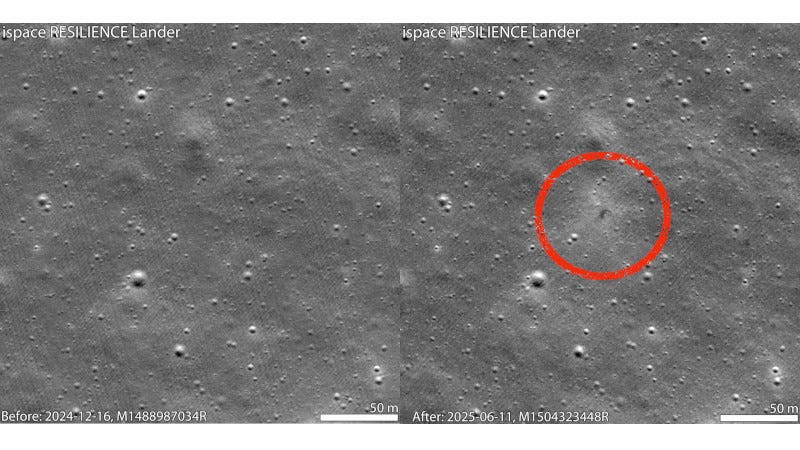NASA’s LRO (Lunar Reconnaissance Orbiter) captured photos last month of the site where the ispace Mission 2 SMBC x HAKUTO-R Venture Moon (RESILIENCE) lunar lander experienced a hard landing on June 5, 2025, UTC.
“Since the moment of landing, we have remained committed to moving forward and identifying the root causes.”
Takeshi Hakamada, ispace
RESILIENCE was launched on Jan. 15 on a privately funded spacecraft.
LRO’s right Narrow Angle Camera (one in a suite of cameras known as LROC) captured the images shown here from about 50 miles above the surface of Mare Frigoris, a volcanic region interspersed with large-scale faults known as wrinkle ridges.
The dark smudge visible above the arrow in the photo formed as the vehicle impacted the surface, kicking up regolith — the rock and dust that make up Moon “soil.” The faint bright halo encircling the site resulted from low-angle regolith particles scouring the delicate surface.
According to ispace, through subsequent and further analysis of telemetry data acquired from the lander confirmed that the technical cause of the hard landing was an anomaly in the LRF hardware. The review also confirmed the issue was not related to the landing guidance control software, nor was it caused by anomalies in the propulsion system or other systems such as power supply.
Based on this conclusion, verification of the LRF anomaly was conducted, focusing on two possibilities:
Potential error in the installation direction during assembly, manufacturing and/or testing, or abnormal attitude of the lander during descent
Deterioration of LRF performance during flight or performance that was lower than expected
The review detected no errors in the installation direction during AIT or attitude abnormalities during descent. The review therefore concluded that the possibility of “deterioration in the performance of the LRF during flight or the performance itself was lower than expected” is high.
This information, including implementing countermeasures and improvements, will be incorporated into planning future missions. As a result of the review ispace has also determined that it will undertake the following initiatives:
Launch an external review task force including third-party experts
Implement further improvement of technical capabilities through expanded collaboration with the Japan Aerospace Exploration Agency (JAXA)
Based on the technical analysis and improvement plan, the re-selection of landing sensors such as LRFs and the review and expansion of testing are estimated to increase combined development costs by a maximum of approximately 1.5 billion yen for Mission 3 (official name: Team Draper Commercial Mission 1) and Mission 4. These costs are expected to be recognized on a phased basis during the period leading up to the planned launches in 2027, so there is no expected impact on the consolidated performance forecast for the fiscal year ending March 2026 and no revisions are needed. There is no expected impact on the current launch schedule for Missions 3 and 4.
"We deeply regret that we were unable to meet the expectations of our shareholders, payload customers, HAKUTO-R partners, government officials, and all others who supported us," said Takeshi Hakamada, Founder & CEO of ispace. “Since the moment of landing, we have remained committed to moving forward and identifying the root causes.
"For the past 18 days, every employee has worked tirelessly to be able to transparently share the results of the technical cause analysis," Hakamada said. "ispace will not let this be a setback. We will not stop here, but as determined pioneers of the cislunar economy, we will strive to regain the trust of all stakeholders and embark on the next mission. “Never Quit the Lunar Quest.”





